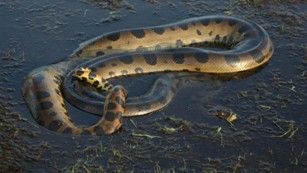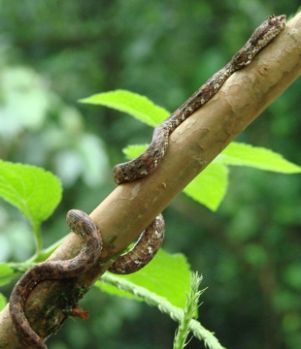Wentyard felt his flesh crawl as he made his way through those dim chambers. The moonlight glinted down through vines tangled across the broken roofs, and shadows lay thick across his path. He reached the chamber where he had slept, and where the coals of the fire still glowed dully. He started across toward the outer door when a soft sound brought him whirling around. A cry was wrenched from his throat.Flashing Blades adventures are filled with conniving courtiers and deadly duelists, but as one would reasonably expect from a game set in 17th century France, there's something of a paucity of big scary creatures. A boar and a great stag, from "The Royal Hunt" in The Cardinal's Peril, are the only animals other than horses to receive any kind of combat stats at all.
Out of the darkness of a corner rose a swaying shape; a great wedge-shaped head and an arched neck were outlined against the moonlight. In one brain-staggering instant the mystery of the ruins became clear to him; he knew what had watched him with lidless eyes as he lay sleeping, and what had glided away from his door as he awoke - he knew why the Indians would not come into the ruins or mount the cliffs above them. He was face to face with the devil of the deserted city, hungry at last - and that devil was a giant anaconda!
In that moment John Wentyard experienced such fear and loathing horror as ordinarily come to men only in foul nightmares. He could not run, and after that first scream his tongue seemed frozen to his palate. Only when the hideous head darted toward him did he break free from the paralysis that engulfed him and then it was too late.
He struck at it wildly and futilely, and in an instant it had him-lapped and wrapped about with coils which were like huge cables of cold, pliant steel. He shrieked again, fighting madly against the crushing constriction-he heard the rush of Vulmea's boots-- then the pirate's pistols crashed together and he heard plainly the thud of the bullets into the great snake's body. It jerked convulsively and whipped from about him, hurling him sprawling to the floor, and then it came at Vulmea like the rush of a hurricane through the grass, its forked tongue licking in and out in the moonlight, and the noise of its hissing filling the chamber.
But our real world contains many species of animals dangerous to people. REH's swashbucklers, frex, face 'monsters' such as the anaconda in "Black Vulmea's Vengeance," or the crocodiles and gorillas of Solomon Kane's adventures. For a campaign with no magical monsters, fierce animals offer a different sort of challenge for the adventurers, and, as REH alludes to in the excerpt quoted above, they can indeed seem like some otherworldly threat.
So here are a few creatures of the Caribbean for your Flashing Blades and High Seas campaigns. All animals in Flashing Blades take general damage as per the core rules.
Anaconda
Found in the swamps and jungles in the north of South America east of the Andes, the green anaconda is a constrictor snake with recorded lengths of more than twenty-five feet. Anacondas are typically found in or near water, which they use to support their bulk and as cover while hunting, submerging all but their nostrils below the surface.
An anaconda attacks by grabbing hold of its prey with its mouth, filled with a hundred small, back-slanting teeth, and crushing it in the coils of its body. In FB, an anaconda first bites with its mouth, striking on a roll of 1-7 on 1D20, causing one point of damage on a successful strike. On a successful bite, the snake may attempt to grapple with a Strength of equal to its hit points; roll on the hit location chart to determine which part of the character's body is grappled by the snake. A successful grapple causes two points of general damage, and continues to cause damage each round the grapple is maintained. If the snake grapples the head, treat it as a Choke attack.
On successive rounds, if the anaconda maintains its hold, it may attempt to grapple again, wrapping another coil of its body around the character. Each coil which successfully grapples causes two points of damage per round, so a character grappled three time by the anaconda takes six points of damage each round the grapple is maintained; each grapple must be broken individually, and characters not grappled by the snake may attempt to help the grappled character break free, using their combined Strength scores. A character with one arms grappled attempts to break a grapple at half-Strength; a character with both arms can only be saved by others.
Anacondas move slowly on land (3 m normal move) but glide quickly through the water (6 m normal move), easily overtaking most swimming men. An anaconda has 15 + 1D6 hit points.
Jaguar and panther
The large cats of the New World, jaguars and panthers are found all around the shores of the Caribbean, from jungles and swamps to forests and scrub. They prey primarily on deer, capybara, and other medium-sized mammals, including feral goats and cattle loosed by sailors and colonists, ambushing their prey from cover such as shrubs or the branches of trees. Attacks on people, such as hunters or boucaniers, are rare but may be deadly when they occur.
Jaguars and panthers usually attack with their claws and bite. A jauguar or panther who successfully strikes on 1-9 on 1D20 with two claws will grapple a character with a Strength of fifteen. The cat will then attempt to bite the character's neck; a bite attack succeeds on a roll of 1-12 on 1D20. Claws and bites each cause two points of general damage; if a character is grappled, roll for the location of a bite attack, with a -2 modifier for each round the cat grapples the character, including the first. If the cat successfully bites the head and neck, the cat may make a Choke attack on successive rounds unless the grapple is broken. A character slain by a jauguar or panther will be dragged away by the cat and hidden under brush or forest litter, to be consumed later.
Jaguars and panthers are faster than humans (12 m normal move) and tend to chase characters who flee - 'run and you'll only die tired,' as I used to explain to park visitors. The big cats have ten + 1D6 hit points.
Alligator and crocodile
Alligators are found along the coast of North America while crocodiles are found on the islands of the Caribbean and along its Central and South American shores in swamps and jungles. They lurk underwater with only their eyes and snouts visible, waiting to strike prey that comes close to the water's edge.
Crocodilians attack with a powerful bite which strikes on 1-8 on 1D20, causing four points of damage; roll for hit location with a +6 modifier to the roll. On a successful bite, an alligator or crocodile attempts to grapple with a Strength equal to its hit points; if the grapple is successful, the crocodile will attempt to drag the character into the water and thrash him to death by rolling over and over, causing four points of general damage per round until the grapple is broken or the character dies.
Crocodilians are capable of extreme bursts of speed (12 m normal move) for a single round, but they lack the endurance to pursue (3 m normal move thereafter). They are powerful swimmers (9 m per round normal move), Alligators and crocodiles have 12 + 1 D6 hit points; their thick hide protects them from two points of damage from each attack.
Viper
Vipers are poisonous snakes found along the Caribbean shores; they include rattlesnakes and water moccasins in North America. Preying on small mammals, they rarely attack people unless they are surprised or disturbed.
A viper attacks with its bite, striking on a roll of 1-6 on 1D20. Roll for hit location with a + 6 modifier for snakes on the ground; arboreal vipers lurking in tree branches, however, roll for hit location with a - 3 modifier instead. A viper's bite is venemous; though it is not usually deadly, it can cause extensive tissue damage. The bite itself causes one point of damage; for 1D6 minutes following a bite, the character must make a check versus Endurance each round, suffering an additional point of damage from the venom for each failed check. If the character succeeds on two successive checks, then no more rolls are required for that wound, but if a character fails three checks in succession, then the bite causes permanent damage; any bite on a limb such as a hand or arm results in amputation - treat as Lose Hand/Lower Limb results - while a bite to the chest, flank, or head results in the permanent loss of one point of Endurance. A surgeon who immediately treats a snake bite allows an extra Endurance save each round, with no penalty for failure of the second check.
Vipers are slow (3 m normal move) but they are - 1 to hit due to their small size. They have only two hit points.
Anacondas, big cats, and crocodilians are opportunistic hunters and may occasionally attempt to take a character as prey. Most will not press an attack if injured, withdrawing if possible if they suffer more than half their hit points in damage rather than fighting to the death, unless they are cornered, starving, or defending their young.





Very nice! It's an area of the FB rules which can definitely use fleshing out.
ReplyDeleteThanks, I have a couple more of these in the pipeline.
DeleteI ran a Rue20 game for a short period using only mundane monsters. Watching the players as they realized that they should probably run from a lion rahter than fight it with a hunting knife was pretty sweet. Anyway, i approve.
ReplyDeleteReal people fear and respect lions, tigers, and bears - no reason their fictional alter-egos shouldn't as well.
DeleteThanks.